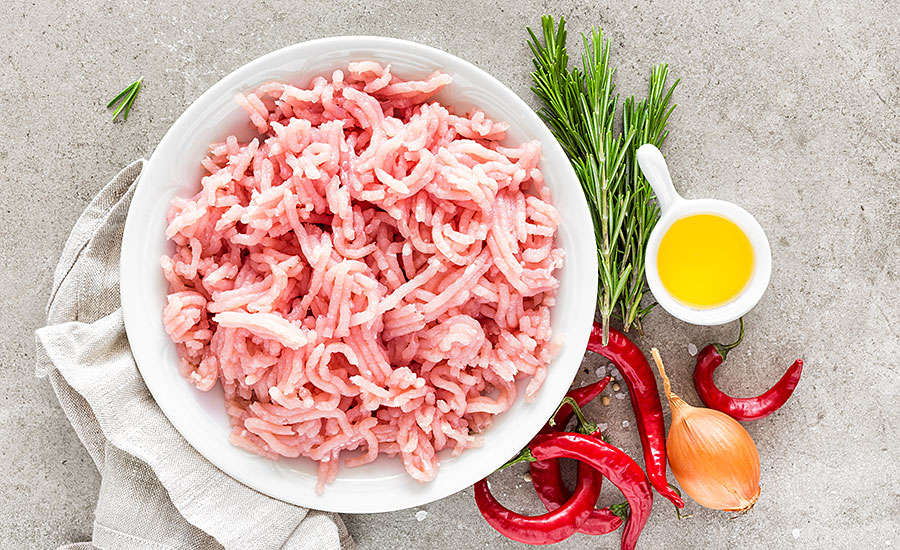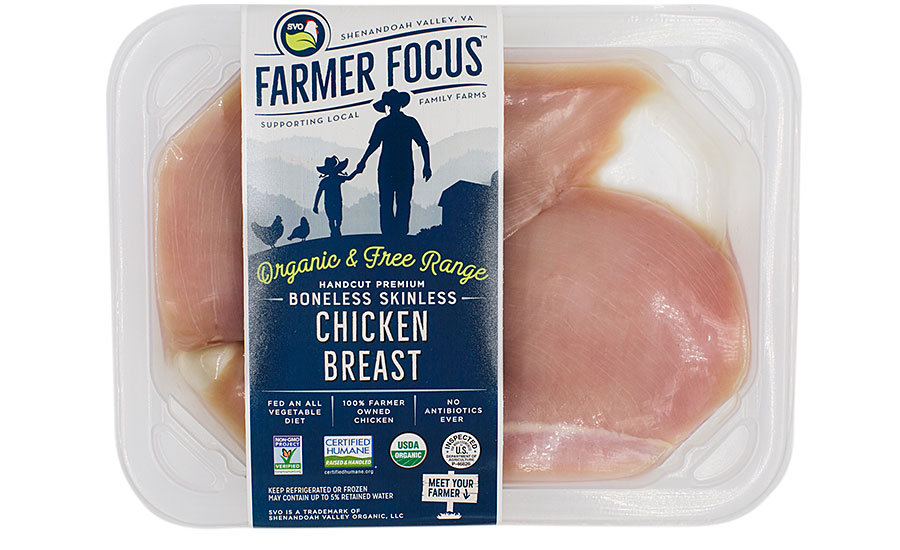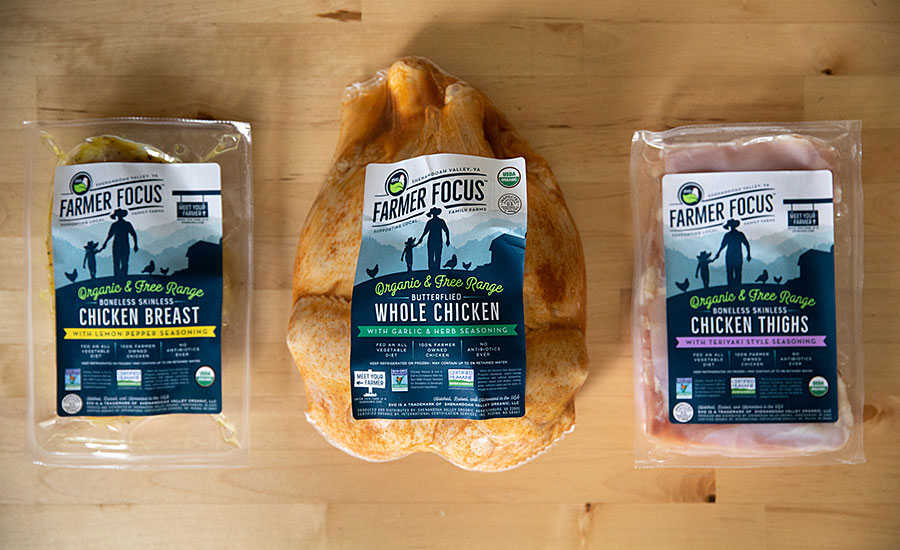The entire chicken category grew 2.5 percent in dollar sales to approximately $20.9 billion, Nielsen Perishables Group, in Chicago, reports for all U.S. outlets combined for the year ending Nov. 3, 2018. Looking at individual departments, the deli department posted the highest dollar sales growth with a 4.7 percent increase from the year before, followed by the meat department with 3.3 percent gains. Frozen chicken dipped 2.3 percent for the period, Nielsen reports.
The entire turkey category also grew, albeit at a slightly slower rate than chicken, with 2.3 percent growth in dollar sales to nearly $2.9 billion, Nielsen reports for the same time period. All departments posted some increase in turkey sales with the deli department in the lead, making double-digit gains to more than $240.5 million.
Article Index:
Information Resources, also based in Chicago, reports the chicken and turkey categories are outperforming total meat overall in dollar sales. The total meat department is up 2 percent, with chicken growing 2.7 percent for the year ending Oct. 31, 2018. Turkey trails at 0.3 percent. The same pattern holds true for volume, but at a somewhat slower rate.
“One of the biggest trends we’d seen is the big push toward value added,” says Chris DuBois, IRI’s senior vice president for strategic accounts. “IRI has been tracking the value-added meat segment closely over the last 5 years, and it’s been a source of outperformance for retailers.”
IRI tracks total sales in value-added meat (uncooked meat that could be refrigerated or frozen, including both fixed and random weight) is up 5.1 percent for the year ending Nov. 3, but value-added chicken is up 11.3 percent. Value-added turkey is up 5.4 percent.
“Not only is value-added meat probably one of the most important segments that’s growing very rapidly, but chicken and turkey are doing extremely well in those areas,” DuBois says. “The whole idea that consumers are looking for easier and shorter preparation methods, more exotic or new ways of seasoning meat have become very big trends. This is a good way for people to try new tastes, try new dishes and save some time in the kitchen.”
The greatest innovations in the poultry category also have been around value-added. While retailers are doing a lot of marinated seasoning, more manufacturers are developing diced and fajita-cut products. “They are trying to find ways to make the form a lot easier to go right from package to the pot, if you will,” DuBois explains.
In addition to value-added poultry budding, a push toward no antibiotics is another large growth area, especially for chicken. Speaking to consumer demands for antibiotic free, Sanderson Farms in Laurel, Miss., announced in November it will join other top poultry producers in discontinuing the use of antibiotics considered medically important for humans, particularly gentamicin and virginiamycin, for disease prevention in its live poultry operation by March 1, 2019.

Chicken sold with the no-antibiotics-ever or antibiotics-free claims grew from 14 percent in 2015 to about 37 percent, IRI reports for the year ending Oct. 31. Turkey sold with antibiotic-free claims has grown to 8.9 percent of the market this year from 5.7 percent three years ago, IRI says.
Additionally, organic chicken now makes up about 4.8 percent of chicken products sold, IRI reports. Five-year-old family-owned organic chicken company Shenandoah Valley Organic (SVO), in Harrisonburg, Va., speaks to the growth of organic, with a just more than 40 percent sales increase this year and a growth to almost 500 employees.
“There is a move toward consumers thinking more about how their food is made, how it gets to them and putting that into the context of their budget in that they will buy organic,” says Jefferson Heatwole, SVO’s co-founder. “Most organic chicken cuts are more affordable than conventional beef cuts, for example, on a cost-per-pound basis.”
With a growing demand for transparency from companies about their food products, SVO rebranded this year with the Farmer Focus.
“You have a source farm ID on each retail package that shows the individual farm from which each chicken came and a little story about the farm and the farmer’s family,” Heatwole explains. “There’s plenty of data coming in that shows that transparency will continue to be a key driver in consumer consideration for food sourcing, and so we certainly view that as a platform from which we can tell our story and engage directly with the end consumer and in a way they can really get behind not just the brand but the process.”
The National Chicken Council (NCC), based in Washington, D.C., also recently developed a series of 360-degree virtual reality videos showing the various stages of chicken’s life during modern commercial production. The new experience is part of NCC’s Chicken Check In program, which serves as a resource for consumers to get the information they seek about how most meat chickens are raised and processed.
Consumer knowledge of protein content
With consumers eating at home more often, more than half of consumers say “high protein” is an important attribute when buying food for their household, according to Nielsen U.S. Homescan Panel Health Care survey from March 2018. In order to see how well consumers understand protein, Nielsen asked more than 20,000 respondents to select how much protein they believe a serving of each food has.
A Nielsen Omnibus Survey from July 2018 found 45 to 64 percent of consumers do not consider chicken along with beef and pork as being high in protein. Chicken breast saw the highest increase in protein knowledge with 38 percent identifying correctly in December 2015 and 42 percent identifying correctly in July 2018. Millennials were the top generation for identifying chicken breasts as having high protein content correctly, followed by GenX.
“We know that people want more information about chicken production and that most have not visited a chicken farm, so we are bringing the farm to them,” says Tom Super, senior vice president of communications for the National Chicken Council. “Through our virtual reality tours, viewers are able to see the way most chickens are hatched, raised and processed in the U.S.”
Pricing matters
As far as cuts of poultry, 2018 saw chicken thighs sales grow, whether boneless, skinless thighs or regular drums. IRI reports these cuts are up 7.4 percent, for the year ending Oct. 31. Wings also saw gains of 5.5 percent. Additionally, ground chicken grew 9.8 percent, with consistent and strong growth during the past three years, DuBois says.
“What we are seeing is continued growth at almost double-digit rates of ground chicken, which shows consumers’ push toward additionally buying more white meat as well as that strong push toward health and wellness,” he says.
In the meat department, Nielsen sees thighs, breasts and wings driving volume growth, while whole chicken and legs are declining. In the deli, rotisserie chicken continues to drive growth while fried chicken is showing declines. In the frozen department, nuggets/tenders and patties are the volume growth-driving areas, and breasts and wings are declining.
“Year after year we continue to see that pricing is the key driver in meat purchasing behavior,” says Meagan Nelson, Nielsen Perishables Group’s associate director.
In regards to pricing, consumers also consider their own “value positions,” meaning what they place value on that would change a purchase decision beyond price, be it production methodologies, packaging concerns or health benefits, Nelson says. With the wide diversity of consumer interest, companies must leverage the values they hold and communicate them to consumers where it matters, she says.
Mike Cockrell, chief financial officer of Sanderson Farms, also sees pricing affecting poultry sales with the lower prices of beef and pork driving restaurants to feature more of those proteins.
“Consumers are having more beef and pork specials thrown at them, and they’re taking advantage of that,” he says. “That is a trend we’ve seen all year, and it affected chicken prices and sales all year. I expect that is going to continue into 2019.”
With Sanderson Farms’ tray pack products performing well at retail, this month the company will open a new plant in Tyler, Texas, for tray pack production. When at full production, the plant will process 1.3 million head of conventionally raised chickens for the grocery store market and add about 9 percent more capacity to the company.
Pricing was also soft for turkeys last year because of the high amount of the protein in the marketplace as well as a slow-to-recover export market, says Joel Brandenberger, president of the National Turkey Federation, in Washington, D.C.

“The fact that there is just a ton of protein period of all kinds out there on the market right now makes for a very competitive environment, and so that’s kept prices from rebounding fully to where we’d like to see, which would be more on a normal level like 2014,” he says.
For organic chicken, fresh, boneless cuts are certainly popular, and continue to trend up, Heatwole says. An area that could use some improvement would be whole birds. While organic consumers do purchase more whole birds than conventional consumers, overall retail purchases have fallen off by almost 50 percent in the last 15 years.
SVO recently launched its first dry-rub products, including Lemon Pepper Boneless Skinless Breasts, Teriyaki Style Boneless Skinless Thighs and a Garlic and Herb Butterflied (spatchcock) Chicken, with additional products in the pipeline for this year.
“They are targeted to consumers who want to prepare a delicious and quality meal, but are strapped for time,” Heatwole says. “In fact, the spatchcock chicken is one way we think we can get people to purchase more whole birds.”
Home consumption
One of the top trends affecting poultry is American consumers’ desire to eat at home regardless of whether the meal is prepared at home or comes from a restaurant, says David Portalatin, food industry advisor at the NPD Group, in Port Washington, N.Y., and author of the report Eating Patterns in America.
“We are increasingly consuming at home, but convenience still matters,” he says. “One of the ways that regardless of where in the food industry you are to be successful with today’s consumer is to give them convenient solutions for creating that in-home meal location.”
Chicken consistently is the leading center-of-the-plate protein Americans eat, Portalatin says. What is changing is that center-of-the-plate proteins are featured in dinners at home a little less often.
“That doesn’t mean that we’re moving away from animal protein,” Portalatin says. “What it means is that our dinners are getting simpler. We’re more likely incorporating the meat as an ingredient to another dish like a sandwich or a pizza or some other kind of mixed dish.”
While sandwiches remain a top food item for lunch, dinner sandwiches are actually increasing, creating an opportunity for chicken sandwiches, Portalatin explains.

In turn, he says chicken strips and nuggets continue to be popular. “The truth is, as a nation we love fried chicken,” he says. “We just don’t call it fried chicken anymore. We call it strips and nuggets.”
Portalatin expects any type of poultry product that enables the consumer to make a relatively simple, yet authentic dish in the home is going to be popular. For example, the food industry continues to see innovation in the freezer case, and frozen dinners and entrees continue to see a slightly growing share of our in-home consumption.
“We’ve seen an awakening recently where manufactures are looking at putting quality back into the products making the freezer case a pathway to real authentic foods for consumers to experiencing bold new flavors and ethnic cuisines,” he says.
With consumers blurring the lines of meal occasions and snacks, Portalatin thinks poultry companies need to look for ways to increase flexibility in their offerings in terms of portion size and price point, which enables consumers to use an item for their more fluid lifestyles.
Answering this trend is new grab-and-go, grilled chicken skewers from ProSticks by Expresco, Montreal. Meant to fuel an active lifestyle, ProSticks are a healthy snack solution with convenient portability and an excellent source of protein.
“We continuously look at improving our products, looking at everything from resealable packaging to innovative flavor palates and, of course, by creating a hand-crafted, high-quality chicken skewer that is ready to eat in a portable format,” says Michael Delli Colli, marketing manager for ProSticks by Expresco. “Containing more than 20 grams of protein, our ProSticks offer a nutritional difference that sets it apart from other snack foods competing for this coveted space on the nutrition facts panel.”
Poultry production

The U.S. Department of Agriculture’s (USDA) forecast for chicken production is to increase 2.5 percent in 2019 over 2018, which compares with 2.1 percent estimated for 2018.
“If, in fact, chicken marketings rise 2.5 percent in 2019, it will be the largest annual increase since 2015 when output rose 3.9 percent which is the long-run annual average increase from 1970 to 2015,” says Tom Super, senior vice president of communications for the National Chicken Council (NCC), in Washington, D.C.
In 2018, according to the USDA’s Agricultural Marketing Service (AMS), the largest size category of broilers averages more than 9 pounds, an increase of 3.5 percent from last year, representing about 30 percent of total liveweight pounds produced.
Much of the leg quarters from these birds are exported, but a good and apparently increasing share of the meat from these cuts remains on the domestic U.S. market in the form of deboned thigh meat.
“Helping to spur this development is that the wholesale price for deboned/skinless thigh meat is comparing more favorable with the price of boneless/skinless breast meat, as reported monthly by USDA’s AMS,” Super says.
Although not extinct, in 2018 it was much more difficult to find 10-pound bags of leg quarters offered at deeply discounted retail prices. This shift has resulted in more leg quarters available for the export market and for further processing, Super says.
More than 7 billion pounds of chicken, mostly leg quarters, are expected by USDA to be exported in 2019, a better than 2.5 percent increase over 2018. This exported quantity would account for 16.4 percent of total chicken marketings. Although chicken exports have made steady, albeit modest, annual gains over the past few years, it is unlikely the record level of exports of 7.345 billion pounds in 2013 will be surpassed this year or, perhaps, even in 2020.
In 2018, the turkey industry saw exports continue to rebound from historic lows it experienced in 2015 and part of 2016 because of the high path avian influenza (HPAI). With the exception of China, which was the industry’s second largest market prior to HPAI, most markets have come back. India, with lower tariffs on turkey than chicken, and Morocco and North Africa, with a new U.S. free trade agreement, offer some bright export sports for turkey moving forward.
“Exports have been a big priority for several years now and will continue to be,” says Joel Brandenberger, president of the National Turkey Federation (NTF), in Washington, D.C.
For example, in 1989 only about 1 percent of all turkeys that were produced in this country went to export. It has been as high as 13 to 14 percent in some years, Brandenberger says.
NTF also is working on the Turkey Demand Project, which looks at ways to maximize existing channels and to open up new channels. For example, last year and into 2019, NTF plans to focus on positioning turkey in the barbecue grilling arena. For the past two years, NTF has participated in the World Series of Barbecue in Kansas City, Mo. “This year we went especially heavy on promoting smoking breast lobe of turkey,” Brandenberger says. “The breast lobe is sort of a turkey equivalent of a brisket.”
Poultry at restaurants
In restaurants, chicken has held steady on menus during the past year as it has for the past four years and is found on 95 percent of menus, says Claire Conaghan, syndicated group manager at Datassential, in Chicago. Turkey is down somewhat, dipping 2 percent during the past year and dropping 5 percent during the past four. Turkey is found at 43 percent of restaurants.
Duck is holding steady on 19 percent of menus, and is flat during the past year and up 3 percent during the past four. Duck is more in line with the indulgence people seek when dining out, which could explain some of this protein’s growth, Conaghan says.
While meat reduction is expected to decrease at restaurants, Conaghan says this is driven by at-home consumption. In addition, Datassential is tracking more flexitarian eating and people avoiding meat.
“Fortunately, most of this reduction is expected to be in the red-meat arena, which may eventually be a positive for poultry,” Conaghan says. “Beyond flexitarian, we are seeing an increase in plant-based eating, which of course is a concern for all meat-based proteins.”
Certain chicken, turkey and other poultry dishes are performing particularly well though. For example, chicken and waffles are a growth area. The dish is now found on 2 percent of menus and up 11 percent during the past year and up 121 percent during the past four, Datassential reports. Buffalo chicken dip also is growing and is now on 1 percent of menus, which is up 7 percent during the past year and 107 percent during the past four years. Hot chicken also is gaining ground and now on 2 percent of menus, up 25 percent during the past year and 75 percent during the past four.
Chicken-based bowls also are increasing, now appearing on 2.5 percent of menus and up 32 percent during the past year and 67 percent during the past four years.
“These speak to the importance of using chicken in indulgent ways,” Conaghan says. “Overall, poultry is positioned as the healthier option, but most growth is coming from new formats and more indulgent applications. If we look at the most declining, it is references to skinless chicken breast, broiled chicken and char-grilled chicken.”

With bowls and regional favorites growth areas for poultry in restaurants, new formats of already favorite dishes also are growing, Conaghan says. “Buffalo chicken is a favorite,” she says. “Why not make it a shareable dip?”
Further highlighting consumers’ affinity for chicken, of the 10 fastest growing restaurant chains in the country, four are chicken places. They include Chick-fil-A, Raising Cane’s Chicken Fingers, Zaxby’s and Wingstop, the NPD Group’s Portalatin says. These chains aren’t introducing any new chicken concepts, but feature chicken strips, wings and breaded chicken sandwiches.
“These chains have the capacity to take something that Americans really love and do it really, really well,” Portalatin explains.
Growing poultry
Clearly communicating to consumers about companies’ products and values will remain important moving forward, Nielsen’s Nelson says. Companies will need to leverage precious real estate on pack as well as in-store signage.
“Transparency and education will remain a key area for all companies no matter their production methodology,” she says.
SVO expects organic chicken to lead category growth along with more value-added products coming to market. “Time-saving options that are less processed with minimal, natural ingredients and those that target consumer trend of increased snacking occasions will drive this growth,” SVO’s Heatwole says.
In addition, ordering online will continue to grow as consumers become more comfortable with that format. Poultry companies will need to work with retailers to ensure online ordering works for the meat department, Nelson says. Nielsen saw in 2018 that nearly 50 percent of grocery online orders were fulfilled via click-and-collect, and having the ordering process intuitive for each unique meat cut is imperative for online ordering efficiencies for consumers, Nelson says.
Millennial consumers also over index in chicken, and preparation times are reducing greatly for that group, which pushes them toward value added, further prepared and prepared foods in supermarkets, IRI’s DuBois says. Millennials now control more than half the total dollars used to purchase food inside of U.S. supermarkets, and they buy 20 percent more chicken than the average U.S. households.
“As supermarkets refine their offerings, they become much more like restaurants in a lot of cases,” DuBois says. “The opportunity for manufactures is to be able to move into those spaces. That’ll continue to be the best place to put additional types of dishes, types of flavors and work with those operators to expand the footprint.”
Overall, DuBois expects a very good 2019 for poultry. “2018 was probably a very hard year for a lot of the big branded manufactures,” he says. “We’ve seen a big rise in private label this year that I know took a lot of the big manufactures back. But I would expect strong growth across the board for chicken and turkey next year. I see continued growth especially in the antibiotic-free and organic segments that we are going to see again two to three times the growth of regular conventional chicken will continue to play out.” NP



